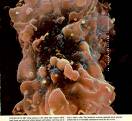Et al
“Truly, a jack of all trades, master of none.”
– Oscar Wilde on Et al
Etimus Albertosi, or Et Al, is a world-reknown immortal Italian scientist publicly heralded for his insatiable lust for research coupled with a limitless devotion to all scientific fields. To date, he has been referenced in 37,512 articles on sociology (mostly regarding voting patterns in the elderly and the effects of the iPod on urban sprawl), 12,336 articles on behavioral science (key references to his works on slapping and teaching misinformation to infants) and a whopping 455,761 articles on cultural anthropology (almost all pointing to his research into the pancultural truth behind Santa Claus).
Recognized as the patriarch of scientific collaboration, Albertosi has famously refused to contribute any works to date composed fully by his own hand. For this reason, it is often unclear what portion of the collaborative work cited can be accredited directly to him. Evidence indicating his personal contributions on landmark research papers is anecdotal at best, save for a few notes scribbled in the margins of various lab reports and memoranda. This fact has acted as a double-edged sword on Albertosi's legacy, for it has created a frantic timor regarding his legitimacy as a researcher. Is he a mysterious, brooding genius, providing subtle direction and insight into the works of laymen? Or, is he that screw-off kid in your high school biology class that gets assigned to a group of A-students and nobody likes him because he doesn't attend any of the group meetings, doesn't take notes in class and still gets credit for the work on an A-project, because everyone is too afraid to give him any real responsibility and let him ruin their chances to get into a good college? No one can say for certain, which is why he is traditionally listed last in all references to works in which he was a "contributor."
Famous Contributions[edit | edit source]
While the substance of his contributions is somewhat of a gray area, it cannot be debated that Albertosi has made contributions to countless group efforts and that the results of those efforts have been referenced. To recount all of those collaborations would mean providing a detailed summary of the history of science. Thus, what follows is a list of his most significant scientific articles (in no particular order, chosen at random by his mother in a double-blind environment), written either by Albertosi himself or his colleagues, along with recollections by his cohorts as to the nature of his assistance on each particular experiment.
July 12th, 1911: The Effect of Nicotine Withdrawal in Dolphins[edit | edit source]
We were approached by James B. Duke, a member of a prominent tobacco farming family in North Carolina who was concerned that his crops were finding their way into runoff water that hit the Outer Banks in spring. People had reported seeing dolphins acting irritable during the fall season--they were edgy, hadn't been sleeping well, waking up in cold sweats, etc. I decided to jump on the idea, so I assembled a group of what I thought were the leading marine biologists and botanists at the time and began our preliminary research. Just my luck, I ran into Albertosi at the library and, in between pages of his Superman comic book, he noticed me taking a book on the dolphin's circulatory system off the shelf. "Whatcha got there?" he asked. That's when I made the mistake of telling him about the experiment. That little leech latched onto the thing like a metroid and spent six months tanning himself, sucking down Coronas and drawing pictures of the dolphins humping each other in the margins of the books we checked out. He fished for hours at a time, while we dug through the muck in 100 degree temperatures. He did nothing of scientific worth. To be fair, he did share the beer and he could grill a mean bratwurst, so he wasn't all bad. He kept us entertained on the slower days with his Amos and Andy impersonations, that's for sure. We didn't have the heart to leave him out of the final copy of the findings, so we just put him last. --Theodore Roosevelt
March 3rd, 1940: The Manhattan Project[edit | edit source]
That little shit! I added him to the team because he's my wife's nephew and she offered to repay me with various bedroom activities, but the unspeakable pleasures at home during that period notwithstanding, it was the worst damn decision of my life! That bastard could not sit still or be serious for one single second, which is typically criterion one when working with nuclear materials. I'll be the first to admit that sneaking up behind people and dropping things down their shirt collars is a hoot, but there is a HUGE barrier of acceptance between ice cubes and decaying uranium ore. We almost kicked him out after we caught him using ore to cook eggs in the hot zone, but we were too busy calculating the aerodynamics of the shell during descent. We were having a problem with cross-drafts pushing our payload east of target and had no idea how in the hell to even start building a guidance system. Now, I know almost counts in the game of nukes, but we had to show the world that, not only could we drop 'em, we could put 'em on a dime. There was a lot of pride at stake. That's when Etimus stepped up to the plate, bigtime. He said as long as we called him Slim Pickens, he'd be willing to sit on the thing and steer it all the way to Charlie's back yard. Sure enough, he followed through on his promise, so we left him in the final publication. He was a headache, though, so we had to put him last. --J. Robert Oppenheimer
October 15th, 1984: The Human Immunodeficiency Virus Epidemic[edit | edit source]
As I remember, we threw him onto the team, because we had heard he was immortal. I mean, it's just a scientific fact: people who can't die stick around a LONG freaking time, buddy. With that in mind, we figured he'd seen quite a bit in his years, especially with all the work he had done in biology, medicine, epidemiology and pornography. No one had a handle on this HIV thing. It was just wiping out queers a thousand at a time. We were desperate. So, this guy shows up, Albertosi or whatever, and says, "Ok, where do I start?" We showed him to his lab station, handed him a white coat and started to review our notes with him. Once he found out the bug jumped over to us from monkeys, he did nothing but spend fourteen months eating bananas and churning out scatterplots--the majority of which were the result of repeatedly opening up shaken cans of grape soda onto sheets of posterboard strewn about the lab. It just so happened that one of those "charts" accidentally ended up conceivably representing the spread rate of the virus in a tiny Boston suburb. We needed a filler on page 82 of the write-up, so the famous Fig. 10.3 came to be--we actually published that shit! Of course, that was all he really accomplished during the life of the study, so we had to put him last when we divvied up the credit. --Tom Hanks, star of Philadelphia
Education[edit | edit source]
Albertosi was home-schooled by his foster parents until his exile for sorcery by the Italian government in 1833. He was taken in by a middle-class soccer family in Westlake, Ohio, where he began his formal education by the graces of the local public school system. It was there that he began to record an impressive history of academic success in groupwork, accumulating four years worth of crystal cultivation, flashpoint analysis, conductivity experiments and team book reports. Much of his scholastic work, however, was marred by accidental stabbings and spillings, cracked and melted lab equipment, contaminated samples and non-life-threatening electrocutions. Yet, his endearing sense of humor and willingness to go the extra mile in getting new file folders and white-out for his teams made him a mainstay during grading periods. Nothing less than perfection was acceptable for any of his team members. Albertosi liked to think that, if not for the effort expended picking up his slack, none of his lab partners would have put forth enough energy to reach that mark each and every time out.
His individual marks were a different story. For every perfect lab write-up, there was a failed essay test peppered with cartoons and misspellings. For every successful presentation on the Civil War, there was a reading quiz with signs of obvious failure to even skim the material (as was the case in his pathetic submission on "Tom Slayer and Raspberry Fins"). It all balanced out to about a C+. However, due to its peculiar nature and its standards for entry, Albertosi earned admission into the Yale Satellite School Exclusively for Group Work in Steubenville, Ohio. From then on, his academic prowess flourished. He latched onto the tail end of such luminary projects as The Effects of Olestra in Porcupines and Terminal Crying: Why Some Babies Just Have to Die. He graduated Summa Cum Laudae, just beating out classmate and rival Andres Otherson (aka: And Others) for valedictorian.
Current Location and Work[edit | edit source]
Since May 23rd, 2006, Albertosi has been retained by NASA to supervise a space mission dedicated to putting a small team of researchers on the surface of Mars. Currently working out of Cape Canaveral on the coast of Florida, he hopes to apply the knowledge he accumulated during his sociological observations of the 1960's space race between the United States and the Soviet Union. To date, he has been integral in the disposal of beakers and the accidental cremation of four lab technicians.





